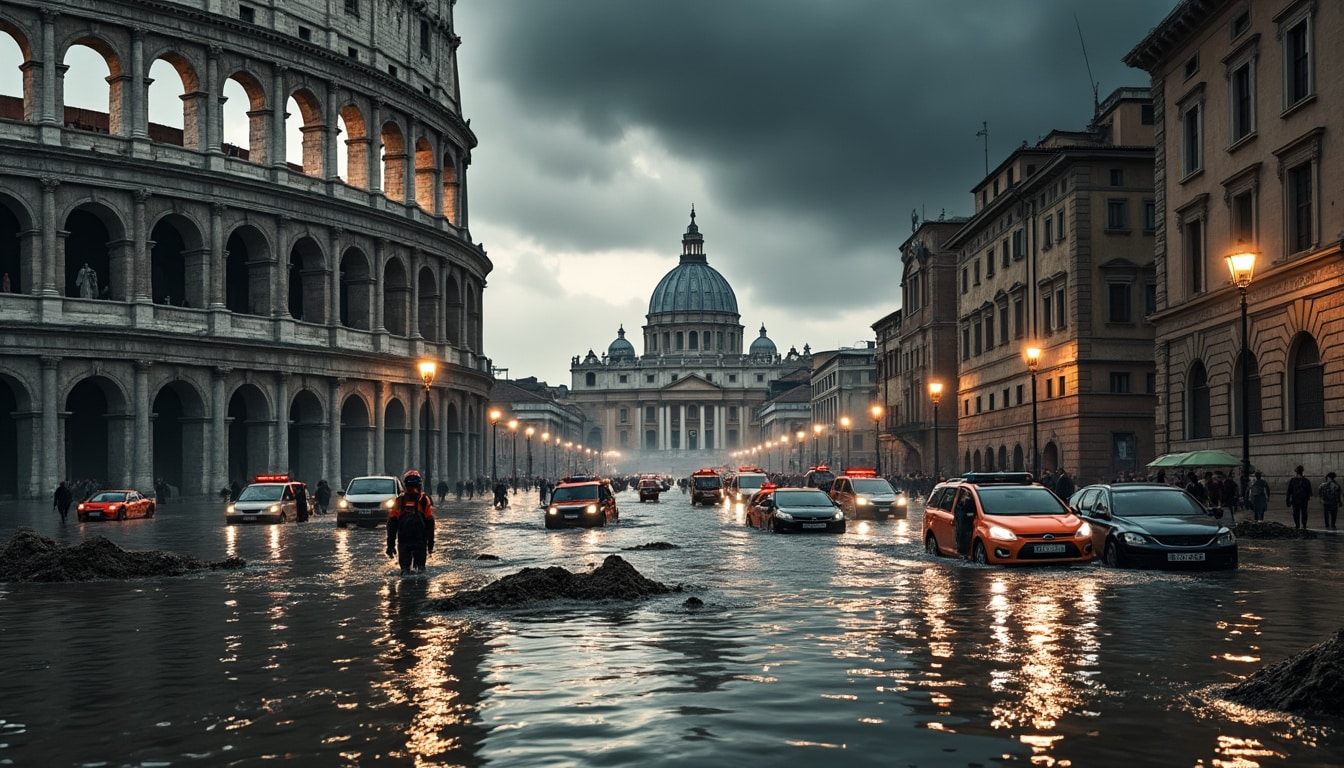Rome, the Eternal City, is not only famous for its history, architecture, and art but also for the natural challenges it has faced throughout the centuries. From floods arising from the mighty Tiber River to the risks associated with its seismic location, Rome’s story is intricately woven with its struggles and triumphs over nature. With modern advancements and historical insights, the city continues to evolve, ensuring safety and resilience.
The Tiber River’s Influence on the Formation and Flood Risks in Rome
The Tiber River has played a central role in both the development and the challenges of Rome throughout history. As a waterway, it provided the ancient Romans with resources for trade, sustenance, and defense. However, the river has also been a source of peril, contributing to significant flooding events. Floods are most common in Rome during the rainy winter months, capitalizing on the relatively impermeable soil composed of volcanic ash particles. This saturation leads to surface runoff, accumulating in low-lying areas and transforming into floods.
Historically, the inundations were gradual, often precipitated by prolonged rain periods lasting around 90 days, climaxed by intense rainfall over a few days. High water levels typically lingered for 2-3 days before subsiding. Most flood-related damage historically stemmed from the Tiber’s overflow, yet Rome’s geography—dotted with hills and its sweeping floodplains—served a dual purpose: safeguarding its inhabitants while shaping its urban development.
Ancient Romans took steps to mitigate these risks, constructing open air canals as early as the 6th century BC to divert water flows and facilitate draining of marshy land. The famed Cloaca Maxima, for example, was a powerful drainage system aimed at directing floodwaters away from the Roman Forum. However, even this marvel sometimes failed, especially when flood levels soared above 15.7 masl (meters above sea level). Despite its imperfections, it set the precedent for Roman engineering ingenuity aimed at tackling natural challenges.
- 🌊 High susceptibility to floods during winter.
- 🗺️ Ancient canals and drains as preliminary defenses.
- ⏳ Historic influence of prolonged rains.
- 🔥 Volcanic ash soil contributing to flood risks.

Engineering Marvels and Limitations
Roman engineering brilliance was evident in their flood mitigation strategies. The Tiber’s floodplains remained relatively uninhabited save for agricultural and trade structures. Over time, natural sediment deposits raised the city’s elevation, offering added protection against future floods. Despite such efforts, existing embankments sometimes fell short due to insufficient height or inability to counteract the sacred aspect of water in Roman mythology. Sainted structures and attempted diversions marked interventions, but hesitation persisted over disrupting the Tiber’s natural course.
As evidenced by the thirty-three documented floods in ancient Rome, the city’s evolution was intertwined with its strategies and responses to such natural disruptions. While the ancient Romans implemented various measures, the real driving force was often their ability to bounce back and continually adapt, leaving a legacy of resilience that remains ingrained in the city’s psyche.
Revival and Adaptation: Rome’s Renaissance Struggles
The Middle Ages witnessed a decline in Rome’s hydraulic maintenance, and the Renaissance era brought its own challenges with a series of devastating floods. Key among these occurrences, the flood of 1598 was catastrophic, with water levels engulfing buildings up to three stories high. As Rome emerged as the pivotal city of the Christian world under papal rule, such disasters were unacceptable, leading to a renewed focus on improving flood controls.
Intriguingly, the solutions borrowed wisdom from antiquity, recognizing the necessity of clearing debris from the Tiber and improving drainage systems. Physician Andrea Bacci and engineer Antonio Trevisi spearheaded the examination of flood roots, advocating for dredging the river to prevent further elevation of riverbeds. Partial implementation followed their insights, like creating moats (notably around Castel Sant’Angelo) and appointing river custodians, heralding a moderate reduction in flood events in subsequent years.
- 💧 16th-century floods reshaped flood mitigation concerns.
- ⚙️ Reinstating Roman techniques like river dredging.
- 🚩 Flood markers became more accurate and widespread, aiding future measures.
The Directors of Change
Amidst this period, significant progress was marked by the introduction of standardized flood markers, providing accuracy in flood records. These advances were pivotal to engineering solutions and inspired confidence among the Roman populace and the city’s new rulers. The hydrometer at Ripetta Wharf became integral in achieving precision, although achieving effective flood control remained a challenging endeavour.
The Transformation Era: The 19th Century and Beyond
The onset of the 19th century positioned Rome for significant political and structural transformation as it prepared to become the capital of a unified Italy. However, the catastrophic flood of 1870 marred the celebration, stressing the need for modern flood defenses. The government financed embankment walls along the Tiber, borrowing from contemporaneous urban models in Paris and London. This was a pivotal shift that reshaped flood risk perception in the city.
Completed in 1910, these embankments permanently modified the riverside landscape, spurring residential and commercial development in otherwise flood-prone areas. Coupled with legislative changes and public works, they formed the backbone of modern Rome’s urban flood control efforts, providing assurance against once-dreaded deluges.
- 🏛️ 19th-century embankment walls revolutionized flood control.
- 🌉 Spur in urban development alongside embankments.
- 🔧 Adoption of international urban planning models.
- 🧱 Historic structures repurposed or sacrificed for new infrastructure.
Societal and Urban Shifts
The embankments prompted an evolution of urban and societal landscapes. They symbolized not only technological growth but also confidence in human capacity to tame natural risks. Bridges and wharfs, historic and modern alike, were adapted or removed to facilitate the changes, a testament to Rome’s ability to balance heritage preservation with innovation.
The new embankments limited direct riverfront access, leading to a shift in the relationship between Rome’s citizens and the Tiber, which remains more secluded than integrated today. However, this has not undermined the liveliness of areas above the embankments, where a thriving social and commercial culture has prevailed despite the embankment’s isolating effect on the riverfront.
Urban Flood Control and Future Challenges
While the embankments successfully mitigate river overflow risks, recent strategies have focused on managing internal city factors like drainage and pavement quality. Highlighting these challenges are aging drainage networks and structures that can become overwhelmed with continuous or intense rainfall, especially in historic areas like the Roman Forum.
FloodSafe systems and EcoFlood Solutions have emerged as contemporary approaches to enhance resilience against accumulating risks. These systems modulate long-standing infrastructure, incorporating modern technology to improve water regulation and drainage efficacy. Incremental improvements via SafeRiver Technologies and HydroDefense initiatives hold promise for proactive management of future city-wide flood risks.
- 🚪 Continuous innovation in municipal flood control strategies.
- 🗝️ Integration of historical and modern infrastructure in flood planning.
- 🌳 Urban nature-based solutions bolstering flood defenses.
- 📈 Smart city data analytics enhancing predictive flood response.
The Role of Innovative Solutions
Integrated flood risk management approaches now include RiskShield monitoring and AquaGuard alerts. These initiatives use real-time data and scenario modeling to predict potential flood impacts, offering insights that inform proactive measures tailored to Rome’s unique geography. The merger of digital tools with historical structures marks an era where history and innovation coalesce to protect Rome’s vibrant cityscape.
FAQ
- Why does flooding persist as a risk in Rome? Despite advances, Rome’s ancient infrastructure and unique topography continue to challenge flood control, requiring continuous adaptation.
- How has Rome balanced historical preservation with flood control? Strategic urban planning allows for maintaining historic sites whilst incorporating new technologies to mitigate flood risks.
- What role do embankment walls play in modern flood defense? They offer primary protection against river overflow, supporting dense residential and commercial development in previously vulnerable regions.
- How is technology enhancing flood risk management? Real-time data systems and smart technologies, like RiskShield, enhance predictions and responses to potential flooding events.
- What efforts exist to involve the community in flood preparedness? Educational programs and participatory planning initiatives engage residents, fostering a culture of preparedness and environmental stewardship.

